Unlock Your Garden's Potential: Mastering the Vegetable Planting Calendar
Ever dream of biting into a juicy tomato you grew yourself, still warm from the sun? Or savoring a crisp salad picked fresh from your backyard? It's not a fantasy, it's entirely within reach with the power of a simple tool: the vegetable planting calendar. This isn't about arcane gardening secrets, it's about harnessing the natural rhythm of the seasons to maximize your harvest and minimize your effort. Ready to ditch the grocery store produce aisle and embrace the abundance of your own garden?
A vegetable planting schedule is your roadmap to gardening success. It tells you the optimal time to sow seeds or transplant seedlings based on your specific climate and the unique needs of each plant. Ignoring this crucial guide can lead to stunted growth, low yields, and the frustration of watching your gardening dreams wither on the vine. Imagine planting frost-sensitive tomatoes too early, only to have them decimated by a late-season cold snap. Or sowing summer squash too late, missing out on the peak growing season altogether. A planting calendar helps you avoid these pitfalls and ensures your garden flourishes.
The concept of a planting calendar is deeply rooted in agricultural history. For centuries, farmers have observed the changing seasons, tracking the patterns of temperature and rainfall to determine the ideal planting times for various crops. This accumulated knowledge, passed down through generations, has evolved into the sophisticated planting guides we have today. These calendars take the guesswork out of gardening, allowing even novice gardeners to achieve impressive results.
Today's vegetable planting calendars incorporate factors like first and last frost dates, average temperatures, and the days to maturity for each crop. They can be customized to your specific location, ensuring you're getting the most accurate information possible. Some advanced resources even account for microclimates within your yard, such as areas that receive more sun or shade.
Understanding your local frost dates is fundamental to successful vegetable gardening. The first frost date is the average date of the first fall frost, while the last frost date is the average date of the last spring frost. These dates mark the boundaries of your growing season and dictate when it’s safe to plant certain vegetables. Tender crops like tomatoes and peppers cannot tolerate frost, so they must be planted after the last frost date. Conversely, cool-season crops like spinach and lettuce can be planted before the last frost and may even thrive in cooler temperatures.
Understanding the days to maturity for each crop is also essential. This number tells you how many days it takes for a plant to reach harvest from the time it's planted. Using this information, you can work backward from your desired harvest date to determine the ideal planting time. For example, if you want ripe tomatoes by mid-July and your tomato variety has a 70-day maturity period, you’ll need to plant your seedlings around early May.
Benefits of a planting calendar: 1. Maximized Yields: Planting at the right time ensures plants have the optimal growing conditions they need to thrive, resulting in bountiful harvests. 2. Extended Growing Season: By strategically planting cool-season crops in the spring and fall, you can extend your harvest and enjoy fresh produce for a longer period. 3. Reduced Waste: Planting the right amount at the right time minimizes the risk of crop failure and reduces food waste.
Action Plan: 1. Determine your first and last frost dates. 2. Choose the vegetables you want to grow. 3. Consult a planting calendar specific to your region. 4. Start seeds indoors or purchase seedlings as needed. 5. Prepare your garden beds. 6. Plant according to your calendar schedule. 7. Water, fertilize, and care for your plants. 8. Enjoy the fruits (and vegetables) of your labor!
Advantages and Disadvantages of Using a Planting Calendar
| Advantages | Disadvantages |
|---|---|
| Maximizes yields | Requires some research and planning |
| Extends the growing season | Can be affected by unpredictable weather |
| Reduces waste |
Best Practices: 1. Use a local planting calendar. 2. Consider your microclimate. 3. Start seeds indoors for a head start. 4. Harden off seedlings before transplanting. 5. Rotate crops to prevent disease.
FAQ: 1. What is a planting calendar? 2. How do I find my frost dates? 3. What are cool-season crops? 4. What are warm-season crops? 5. How do I start seeds indoors? 6. How do I harden off seedlings? 7. How do I rotate crops? 8. What are common gardening mistakes?
Tips and Tricks: Pay attention to seed packet instructions. Use companion planting to enhance growth and deter pests. Mulch around plants to retain moisture and suppress weeds.
Embracing a vegetable planting calendar is a simple yet powerful step towards achieving gardening success. By following the rhythms of nature and utilizing this valuable tool, you can unlock your garden's full potential, maximize your harvests, and enjoy the incredible satisfaction of growing your own food. It's a rewarding experience that connects you to the earth, nourishes your body, and reduces your reliance on the grocery store. So, grab a planting calendar, get your hands dirty, and start growing! This investment in time and effort will pay off dividends in the form of fresh, healthy, and delicious homegrown produce for years to come. Don't delay, start planning your dream garden today!
Tracing lifes journey the evolutionary tree
Effortless elegance simple balloon arrangements that steal the show
Download sale deed online west bengal your essential guide














